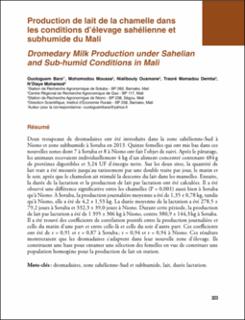| dc.contributor.author | Ouologuem, Bara | |
| dc.contributor.author | Mohomoudou, Moussa | |
| dc.contributor.author | Nialibouly, Ousmane | |
| dc.contributor.author | Traoré, Mamadou Demba | |
| dc.contributor.author | N'Diaye, Mohamed | |
| dc.coverage.spatial | Mali | en_US |
| dc.date.accessioned | 2020-11-15T15:37:32Z | |
| dc.date.available | 2020-11-15T15:37:32Z | |
| dc.date.issued | 2020 | |
| dc.identifier.isbn | 978-99952-803-4-5 | |
| dc.identifier.uri | https://hdl.handle.net/11250/2687909 | |
| dc.description | Citation correct de ce document / Correct citation of this document: Ouologuem, B. et al. (2020). Production de lait de la chamelle dans les conditions d’élevage sahélienne et subhumide du Mali. In: N'Diaye, I. et al. (eds.) Adaptation de l'Agriculture et de l'Élevage au Changement Climatique au Mali: Résultats et leçons apprises au Sahel. Bamako, Mali: Institut d'Economie Rurale. pp. 323-334. | en_US |
| dc.description | Le livre complet est accessible sur le site internet suivant / The complete book can be accessed from the following link https://hdl.handle.net/11250/2687372 | |
| dc.description.abstract | Résumé: Deux troupeaux de dromadaires ont été introduits dans la zone sahélienne-Sud à Niono et zone subhumide à Sotuba en 2013. Quinze femelles qui ont mis bas dans ces nouvelles zones dont 7 à Sotuba et 8 à Niono ont fait l’objet de suivi. Après le pâturage, les animaux recevaient individuellement 4 kg d’un aliment concentré contenant 484 g de protéines digestibles et 3,24 UF d’énergie nette. Sur les deux sites, la quantité de lait trait a été mesurée jusqu’au tarissement par une double traite par jour, le matin et le soir, après que le chamelon ait stimulé la descente du lait dans les mamelles. Ensuite, la durée de la lactation et la production de lait par lactation ont été calculées. Il a été observé une différence significative entre les chamelles (P = 0,001) aussi bien à Sotuba qu’à Niono. À Sotuba, la production journalière moyenne a été de 1,35 ± 0,78 kg, tandis qu’à Niono, elle a été de 4,2 ± 1,53 kg. La durée moyenne de la lactation a été 278,5 ± 79,2 jours à Sotuba et 332,3 ± 39,0 jours à Niono. Durant cette période, la production de lait par lactation a été de 1 395 ± 306 kg à Niono, contre 380,9 ± 144,3 kg à Sotuba. Il a été trouvé des coefficients de corrélation positifs entre la production journalière et celle du matin d’une part et entre celle-là et celle du soir d’autre part. Ces coefficients ont été de r = 0,91 et r = 0,87 à Sotuba ; r = 0,94 et r = 0,94 à Niono. Ces résultats montreraient que les dromadaires s’adaptent dans leur nouvelle zone d’élevage. Ils constituent une base pour entamer une sélection des femelles en vue de constituer une population homogène pour la production de lait en station. | en_US |
| dc.description.abstract | Abstract: Two herds of dromedaries were introduced in the Southern Sahel zone (Niono) and the sub-humid zone (Sotuba) in 2013. Fifteen females, i.e. 7 in Sotuba and 8 in Niono, which gave birth in these new environments, were monitored. After grazing, each animal received 4 kg of a concentrated feed containing 484 g of digestible protein and 3.24 UF of net energy. In both sites, the amount of milk was measured until drying off through double milking per day in the morning and the evening after the young dromedary has stimulated milk flowing into the udders. Then, the duration of lactation and milk production by lactation were calculated. There was a significant difference between dromedaries (P = 0.001) in both Sotuba and Niono. The average daily production was 1.35 ± 0.78 kg in Sotuba, while it was 4.2 ± 1.53 kg in Niono. The mean duration of lactation was 278.5 ± 79.2 days in Sotuba and 332.3 ± 39.0 days in Niono. During this period, the average milk production per lactation was 1,395 ± 306 kg/dromedary in Niono, compared with 380.9 ± 144.3 kg in Sotuba. Positive correlation coefficients were found between daily and morning production on the one hand and between the latter and the evening one on the other hand. These coefficients were as follows: r = 0.91 and r = 0.87 in Sotuba and r = 0.94 and r = 0.94 in Niono. These results show that dromedaries are adapting themselves to their new farming area. They also provide a basis for initiating a selection of females to form a homogenous population for in-station milk production. | en_US |
| dc.language.iso | fre | en_US |
| dc.publisher | Institut d’Économie Rurale (IER), Bamako, Mali | en_US |
| dc.rights | Attribution-NonCommercial-NoDerivatives 4.0 Internasjonal | * |
| dc.rights.uri | http://creativecommons.org/licenses/by-nc-nd/4.0/deed.no | * |
| dc.subject | dromadaire | en_US |
| dc.subject | lait | en_US |
| dc.subject | durée lactation | en_US |
| dc.subject | zone sahélienne-Sud et subhumide | en_US |
| dc.subject | dromedary | en_US |
| dc.subject | Southern Sahel and sub-humid zone | en_US |
| dc.subject | milk | en_US |
| dc.subject | duration of lactation | en_US |
| dc.title | Production de lait de la chamelle dans les conditions d’élevage sahélienne et subhumide du Mali | en_US |
| dc.title.alternative | Dromedary Milk Production under Sahelian and Sub-humid Conditions in Mali | en_US |
| dc.type | Chapter | en_US |
| dc.type | Peer reviewed | en_US |
| dc.subject.nsi | VDP::Landbruks- og Fiskerifag: 900::Landbruksfag: 910::Husdyravl, oppdrett, forplantning: 912 | en_US |
| dc.source.pagenumber | 323-334 | en_US |
| dc.relation.project | Projet Adaptation de l’Agriculture et de l’Élevage au Changement Climatique / Adaptation of Agriculture and Livestock to Climate Change project | en_US |

